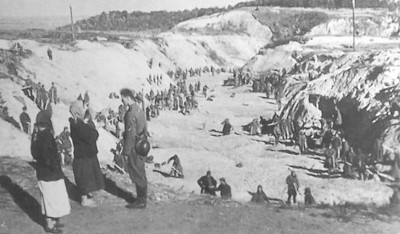The "Train of Remembrance" in Gelsenkirchen
 | The "Train of Remembrance"The Train of Remembrance is a museum train rolling across Germany giving insights about the fate of more than 1 million children
- of Jewish
- or Roma/Sinti (usually called "Gypsies" in English)
- or anti-nazi parents during world war II. mournful souls
bound for redemption
you shall not be forgotten
(Song of the project: "Searching for Traces") |  | Children - What did they do to deserve such a fate?Between October 1940 and December 1944, the Nazis deported an estimated 1 million children of Jewish, Sinti/Roma or anti-nazi parents or more. The German Reichsbahn railway corporation hauled them to their death, mostly to the Auschwitz concentration camp, where they died from toxic gas, from starvation, from diseases, or were gunned down. |  | An authentic Reichsbahn train engine.Today's Deutsche Bahn railways is the legal successor of the Reichsbahn. But despite the fact that the Reichsbahn earned lots of money through deportations during the Holocaust, they are reluctant to face their past - which caused outrage internationally (and rightly so). |  | The Railway engine Posen (today Poznan, Poland) was fixed and rebuilt in Romania in 2001. |  | In run-down overcrowded freight cars the children went towards their death, in burning hot summers, in icy winters, forsaken, helpless, pictures of misery.
They even had to pay 4 pfennigs per kilometer for this journey. Last messages were found on German tracks, desperate cries for help, scraps of letters, postcards. Gone with the wind. "My tears are falling like rain from the sky, Is it for you or myself that I cry..." |  | Children - What did they do to deserve such a fate?What a lovely face, bound to die very soon ... last photo of Graciella Samuel from Greece. |  | Crying children, weeping mothers ...Nobody knows how many children survived the KZs, there is no register. There were not only German children on the trains of death but from all over Europe, from France, the Netherlands, Belgium, Italy, Poland, Norway, Yugoslavia, Greece, Austria, Hungary, the Baltic countries, the Soviet Union, Czechoslovakia. |  | Where are our parents? You murderers!The exhibition, with the biographies of the missing children, is installed in two train cars and is being pulled by a steam engine over the tracks of the German rail system. Nazi troops abducted more than a million children, from all over Europe, and transported them to German death camps, over the rails of the former "Deutsche Reichsbahn," that had placed its logistics at the disposal of the mass murderers. Only a few survivors returned... |  | The Babi Yar massacreBabi Yar is a ravine in Kiev, the capital of Ukraine. In the course of two days, September 29 and 30, 1941, German Nazis aided by their collaborators murdered 33.771 Jewish civilians. The Babi Yar massacre is considered to be the largest single massacre in the history of the Holocaust. All were driven down a corridor of soldiers, in groups of ten, and then shot. The crowd was large enough that most of the men, women, and children could not have known what was happening until it was too late: by the time they heard the gunfire, there was no chance to escape. |  | Two little girls, born in Gelsenkirchen Siblings, two little girls born in our town, deported and murdered by the Nazis, when 4 and 6 years old. Abt 140 children of our town were deported, only a few survived. For more than 60 years the perpetrators and the people assisting them tried to make the public forget these children's fate. Nobody was held accountable for it. One of the main organizers of the train loads of deportees lived on happily for another 23 years after his case was dismissed. 23 years he never granted to the children he had crammed into the train cars on their way to the concentration camps. |  | Children of Gelsenkirchen today, reading thoughtfully ...Comment of a visitor: "It's enraging to see how many perpetrators never went to jail - let's be more vigilant." A 15-year-old girl: "Without wanting to sound cold-hearted, but this thing happened - and there's nothing we can do about that. However, we can learn from it. That's the only way to prevent this from happening again. Our generation will have the responsibility soon and this train provides us with the knowledge we need. It made me think - I will do everything I can that these things will never happen again." |  | When the exhibition was opened in Gelsenkirchen, Herman Neudorf, born in our town on June 3rd, 1925, who lives now in the USA, sent greetings to Andreas (see photo) who did a good job managing the event, in volunteer work. |
This is Herman's preface to the Train of Remembrance's arrival at Gelsenkirchen: Dear Andreas, let me answer without delay. Here are my thoughts about the "Train of Remembrance". On October 28, 1938 a policeman came to my school in Gelsenkirchen and threw me into jail. I was only 13 years old. That was the day my youth was over. - I was deported to Poland, then to Riga, then to the concentration camps of Stutthof and Buchenwald where I finally was liberated in 1945. It's easier to forgive than forget. To forget about the past will be impossible for me. Therefore I wish all the best for the Train of Remembrance! And let me express my gratitude towards those people who keep the memory of these atrocities and the memory of our fate alive! Lieber Andreas,... It is people like you who gave me back the believe in the kindness of the human race. With good wishes, your friend Herman Neudorf The "Train of Remembrance"
Text: Marlies Niehues † 2008
Fotos: Wilhelm Niehues (Except Nr. 1, 5, 8, 9)
|